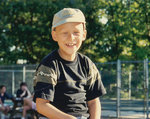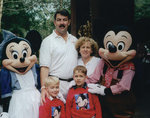Nancy Haight understands the lifesaving power of blood even though cancer claimed the life of her beloved son, Ben, 18 years ago.Throughout Ben’s heroic …
This item is available in full to subscribers.
We have recently launched a new and improved website. To continue reading, you will need to either log into your subscriber account, or purchase a new subscription.
If you are a current print subscriber, you can set up a free website account by clicking here.
Otherwise, click here to view your options for subscribing.
Please log in to continue |
|


Nancy Haight understands the lifesaving power of blood even though cancer claimed the life of her beloved son, Ben, 18 years ago.
Throughout Ben’s heroic fight, he always had a smile. He loved being around people and with his Little League team. He galvanized the community at a time before social media became a rallying force with its ability to raise funds and bring people together to help one another.
Ben still serves as an inspiration, a testament to the power of strangers helping strangers and how a boy undergoing extended hospital treatments can think to bring joy to other children.
In the last 22 months of his life, after his relapse, Ben used more than 200 units of blood products. It kept him alive, enabling him to return to school – even though at that point, doctors had done all they could, including turning to an experimental drug that at first seemed to be working.
Nancy knew the important role blood played in helping Ben in his initial fight against neuroblastoma, which it appeared he had conquered after two stem cell transplants. Then, after two years, came the relapse when he was so dependent on platelet transfusions.
Normally, Nancy said, a good platelet level is 50,000. Ben’s was around 12,000. Also, she explained that platelet transfusions are blood-type specific and on one visit to the hospital for his regular transfusion – about three per week – she was told the center was out of platelets of Ben’s blood type. They could wait at the hospital or they could leave and come back when the platelets were available.
Ben wanted to go home and ride his bike. Yet, Nancy knew if he fell and cut himself that could be serious, maybe resulting in death.
“We were depending on strangers to come in and donate platelets for Ben,” she remembers realizing, and she knew she wanted to do something to give back.
That memory motivated her to run the first Ben Haight Memorial Blood Drive a year after his death. At the time, it was the Rhode Island Blood Center’s largest individual-sponsored drive in its history with a collection of more than 150 units.
Meeting the need
The annual blood drive held in Ben’s name returns for its 17th year next week, on Wednesday, Jan. 8, from 3-7 p.m. at St. Mark’s Church, located at 111 West Shore Road in Warwick.
Kara LeBlanc, who handles marketing and media relations for the Rhode Island Blood Center, said the drive – which is taking place during National Blood Donor Month – symbolizes the strength that can emerge in the face of loss and the resonance one family’s story can have throughout the broader community.
“I think it’s really wonderful to not forget what [Ben] needed and to years later still be advocating for others … Their commitment to making sure that other people have what they need is astounding,” she said.
She added: “[Nancy is] continuing to do something beautiful to honor her son’s life … It doesn’t always have a happy ending, but the blood products that [Ben] received gave her more time with her son. He wouldn’t have had a fighting chance if it hadn’t been for the people who came and gave regularly.”
The need for blood donors remains significant. To provide context, LeBlanc said what was given to Ben during the treatment after his relapse represents roughly the amount of donations the Blood Center must collect each day to meet demand.
“We have to collect over 200 blood products a day, every day, to meet the needs of the hospitals and patients that we serve,” she said, adding that the center is the sole supplied of blood products to Hasbro Children’s Hospital and The Tomorrow Fund Clinic.
The winter months can be a challenging time for blood donation efforts, LeBlanc said, largely due to the unpredictability of the weather. She noted that storms in December have already created a deficit in terms of donation efforts.
“One bad day of weather can cancel all of our mobile drives,” she said.
As part of the effort to boost donations during the winter, January has been designated as National Blood Donor Month. During the month ahead, LeBlanc said, donors at all locations across the state will receive a $5 Dunkin’ gift card “as a little ‘thank you’ for making that extra effort.”
The hope, she said, is that the Blood Center can expand its base of consistent donors.
“Overall, the donor base is declining everywhere across the U.S.,” LeBlanc said. “And what we need more than anything are people who are eligible to give to donate, but also people to actually try for the first time in January.”
The Blood Center also encourages community members who are interested in organizing their own donation drives. A link through the center’s website, ribc.org, provides full information on how to get started, and staff at the center provide guidance through the entire process.
LeBlanc said a “personal ask” from a friend or family member is typically the most effective means of getting new donors involved.
“That’s the thing that gets people to donate more than anything else, having that conversation,” she said.
She also noted that the drive held in Ben’s honor has resulted in 804 donations over the years – and since each donation can help three people, its reach has been significant.
“It’s something really tangible you can do to help people in difficult situations, and certainly something beautiful you can do to honor them … It has to come from one human being to another,” she said.
Cancer’s toll
According to the Alex’s Lemonade Stand Foundation, nearly 15,600 children in the United States – 43 each day – were diagnosed with cancer in 2018. An estimated 300,000 children are diagnosed with the disease globally each year, although the foundation suggests that figure may be low.
Annually, roughly 1,800 children across the country die from cancer. According to figures from the Centers for Disease Control and Prevention, cancer is the leading cause of death for those between the ages of 1 and 19.
Nancy has made advocacy for childhood cancer research another aspect of her efforts to honor Ben’s memory. She and members of her family have traveled to Washington, D.C., to lobby federal lawmakers on the issue, and she said U.S. Sens. Jack Reed and Sheldon Whitehouse and former U.S. Rep. Patrick Kennedy were “great supporters” of their efforts.
“Unfortunately, there is not a lot of outrage about or attention paid to pediatric cancer and the government does not allocate a lot of funding for research into childhood cancers, in spite of the fact that some treatments for childhood cancers have translated to treatments for adult cancers, but the inverse has never been the case,” Nancy said.
She added: “There is justifiably so much outrage about gun violence in our schools, but people don’t realize … how many children we lose to this insidious disease each year.”
Giving spirit
Even at only 5 years old, Ben was a giver.
In the early stages of his battle, it seemed doctors were constantly prodding and poking him and doing blood tests. Nancy leaned on the staff to reduce the persistent blood tests after Ben appealed to her to come to his aid. The tests were reduced, but on one occasion Ben was given a plain bandage rather than one of the “silly” bandages with fun cartoon characters. He was told there was none left.
Ben mounted a drive for kids’ Band-Aids at John Brown Francis School, which quickly became a community drive. Two giant cartons of Band-Aids were collected for the Tomorrow Fund Clinic at Hasbro Children’s Hospital.
Ben was asked at the time why he was collecting the Band-Aids.
“Because it makes kids happy,” he told a Warwick Beacon reporter.
The community rallied to help the Haights, too, raising funds to help with medical expenses following his relapse.
Nancy remembers school Superintendent Robert Shapiro allowing Ben’s fellow students to wear hats so that Ben wouldn’t feel out of place with his loss of hair. But Ben didn’t want the special dispensation and took off his hat. He wanted to be treated equally.
“He inspired a lot of people by his courage,” Nancy said.
That memory inspires her to carry on, and she remains hopeful that Ben’s story resonates with those who give not knowing who they are helping, as it was strangers who enabled Ben to be Ben as long as he lived.
Comments
No comments on this item Please log in to comment by clicking here